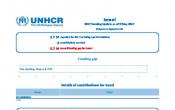Israel
Operation: Israel
Location
{"longitude":35,"latitude":33,"zoom_level":7}
Latest update of camps and office locations 21 Nov 2016. By clicking on the icons on the map, additional information is displayed.
Key Figures
| 2016 year-end results | |
| 4,510 | asylum-seekers with specific needs were supported |
| 2,040 | asylum-seekers were counselled, including 45 asylum-seekers in detention |
| 1,590 | asylum-seekers were provided with legal assistance |
| 256 | cases of individuals were submitted for resettlement |
| 2017 planning figures | |
| 5,000 | people of concern with specific needs will be supported through advocacy, legal or medical/psycho social interventions |
| 200 | people of concern will receive skills training for livelihood purposes |
| 200 | refugees will be submitted for resettlement |
| 50 | community members will be trained in SGBV prevention and response |
| 22 | community groups will be supported to allow them to better advocate for their needs |
Latest Updates
People of Concern
1%
Decrease in
2016
2016
| 2016 | 44,665 |
| 2015 | 45,106 |
| 2014 | 45,284 |

[["Refugees",411],["Refugee-like situation",32535],["Asylum-seekers",11677],["Stateless",42]]
Loading ...
Israel
< Back
2016
{"categories":[2012,2013,2014,2015,2016,2017],"budget":[3.12954461,3.22276023,2.9347088,3.20793918,3.07990377,3.73197219],"expenditure":[2.27217866,2.86515197,2.6475354,2.75589838,2.67243925,null]}
{"categories":[2012,2013,2014,2015,2016,2017],"p1":[3.12954461,3.22276023,2.9347088,3.20793918,3.07990377,3.73197219],"p2":[null,null,null,null,null,null],"p3":[null,null,null,null,null,null],"p4":[null,null,null,null,null,null]}
{"categories":[2012,2013,2014,2015,2016,2017],"p1":[2.27217866,2.86515197,2.6475354,2.75589838,2.67243925,null],"p2":[null,null,null,null,null,null],"p3":[null,null,null,null,null,null],"p4":[null,null,null,null,null,null]}
Loading ...
CHOOSE A YEAR
- 2015
- 2016
- 2017
Year-end Overview
Working environment
Israel is a party to the 1951 Convention and the 1967 Protocol Relating to the Status of Refugees, although this is not reflected in the country’s legal framework. The protection space for refugees and asylum-seekers was restricted. Detention was imposed on asylum-seekers for a period of three months upon arrival, followed by residence in a semi-open facility (Holot) in the Negev desert for up to one year. Asylum-seekers are also offered a payment (USD 3,500) to relocate to third countries. Since 2009, only 8 Eritreans and 2 Sudanese have been recognized as refugees by the Government.Population trends
- A number of Eritreans and Sudanese signed up for voluntary departure, or departed through resettlement, sponsorship or family reunification pathways. As a result, the total number of Eritrean and Sudanese asylum-seekers decreased from 40,017 to 37,016.
- At the end of 2016, the total number of asylum-seekers was 40,274: 29,014 Eritreans, 8,002 Sudanese, 2,754 other African countries, 504 from other countries.
- The Ministry of the Interior recorded 18 new irregular arrivals (all from Sudan) in 2016, a decrease from 220 in 2015. The Ministry of the Interior also recorded 12,065 Ukrainian and Georgian citizens since 2014 have arrived in Israel as tourists and subsequently filed asylum claims.
Achievements and impact
- Solutions Strategy presented to the Minister of Interior, leading to an agreed approach of a pilot project.
- UNHCR monitoring of the asylum-seeker population identified protection needs (2,042 individuals), including victims of trafficking or torture (321 new cases), who received assistance as appropriate.
- Interventions were made by legal partners to release or exempt 140 asylum-seekers from detention.
- Participatory assessments were conducted in seven cities.
- Vocational training was provided to 237 participants, focusing on business, finance and marketing skills, computer technician and user skills, video editing, public speaking as well as cellphone repair, hairdressing, sewing and welding.
- New partnerships addressing legal/practical obstacles for asylum-seekers with disabilities and family planning were established.
- UNHCR conducted outreach including communicating with communities and workshops on HIV/AIDS prevention and awareness.
Unmet needs
- Current legal and policy framework was inadequate and opportunities for durable solutions were limited.
- There was a lack of housing, financial, medical and/or psycho-social services for 243 SGBV-affected asylum-seekers.
- UNHCR’s partner, Mesila, was only able to assist 724 of 1,246 identified child-abuse cases due to a lack of resources.
Plan Overview


